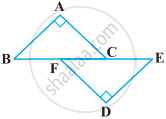Advertisements
Advertisements
प्रश्न
Prove that in a quadrilateral the sum of all the sides is greater than the sum of its diagonals.
उत्तर
We have to prove that the sum of four sides of quadrilateral is greater than sum of diagonal.

Since the sum of two sides of triangle is greater than third side.
In ΔPQR we have
PQ + QR > PR ..........(1)
In ΔRSPwe have
RS + SP >PR ..........(2)
In ΔPQS we have
PQ + SP > QS ........(3)
In ΔQRSwe have
QR + RS > QS .........(4)
Adding (1) & (2) & (3) and (4) we get
2(PQ + QR + RS + SQ ) >2 (PR + QS)
Hence (PQ + QR + RS + SQ > PR + QS)Proved.
APPEARS IN
संबंधित प्रश्न
AD is an altitude of an isosceles triangles ABC in which AB = AC. Show that
- AD bisects BC
- AD bisects ∠A
ABC is an isosceles triangle with AB = AC. Drawn AP ⊥ BC to show that ∠B = ∠C.
In two right triangles one side an acute angle of one are equal to the corresponding side and angle of the other. Prove that the triangles are congruent.
In the following figure, BA ⊥ AC, DE ⊥ DF such that BA = DE and BF = EC. Show that ∆ABC ≅ ∆DEF.

ABC is an isosceles triangle in which AC = BC. AD and BE are respectively two altitudes to sides BC and AC. Prove that AE = BD.
In a right triangle, prove that the line-segment joining the mid-point of the hypotenuse to the opposite vertex is half the hypotenuse.
Line segment joining the mid-points M and N of parallel sides AB and DC, respectively of a trapezium ABCD is perpendicular to both the sides AB and DC. Prove that AD = BC.
ABCD is a quadrilateral such that diagonal AC bisects the angles A and C. Prove that AB = AD and CB = CD.
ABC is a right triangle such that AB = AC and bisector of angle C intersects the side AB at D. Prove that AC + AD = BC.
ABCD is quadrilateral such that AB = AD and CB = CD. Prove that AC is the perpendicular bisector of BD.
